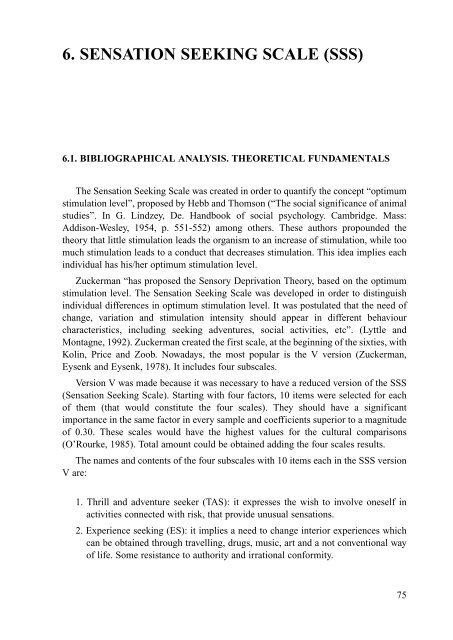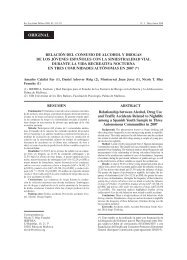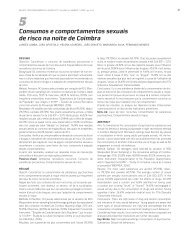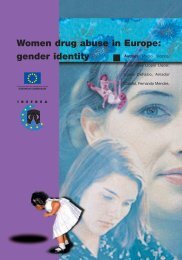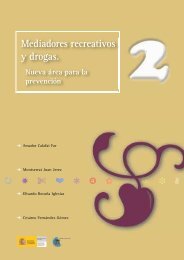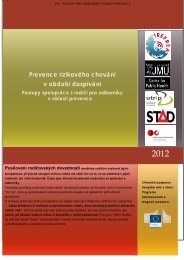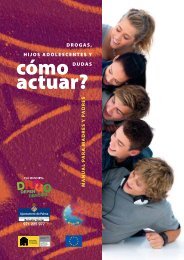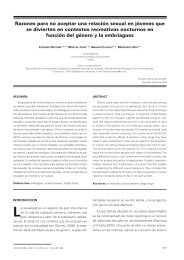Characteristics and social representation of ecstasy in Europe - Irefrea
Characteristics and social representation of ecstasy in Europe - Irefrea
Characteristics and social representation of ecstasy in Europe - Irefrea
You also want an ePaper? Increase the reach of your titles
YUMPU automatically turns print PDFs into web optimized ePapers that Google loves.
6. SENSATION SEEKING SCALE (SSS)6.1. BIBLIOGRAPHICAL ANALYSIS. THEORETICAL FUNDAMENTALSThe Sensation Seek<strong>in</strong>g Scale was created <strong>in</strong> order to quantify the concept “optimumstimulation level”, proposed by Hebb <strong>and</strong> Thomson (“The <strong>social</strong> significance <strong>of</strong> animalstudies”. In G. L<strong>in</strong>dzey, De. H<strong>and</strong>book <strong>of</strong> <strong>social</strong> psychology. Cambridge. Mass:Addison-Wesley, 1954, p. 551-552) among others. These authors propounded thetheory that little stimulation leads the organism to an <strong>in</strong>crease <strong>of</strong> stimulation, while toomuch stimulation leads to a conduct that decreases stimulation. This idea implies each<strong>in</strong>dividual has his/her optimum stimulation level.Zuckerman “has proposed the Sensory Deprivation Theory, based on the optimumstimulation level. The Sensation Seek<strong>in</strong>g Scale was developed <strong>in</strong> order to dist<strong>in</strong>guish<strong>in</strong>dividual differences <strong>in</strong> optimum stimulation level. It was postulated that the need <strong>of</strong>change, variation <strong>and</strong> stimulation <strong>in</strong>tensity should appear <strong>in</strong> different behaviourcharacteristics, <strong>in</strong>clud<strong>in</strong>g seek<strong>in</strong>g adventures, <strong>social</strong> activities, etc”. (Lyttle <strong>and</strong>Montagne, 1992). Zuckerman created the first scale, at the beg<strong>in</strong>n<strong>in</strong>g <strong>of</strong> the sixties, withKol<strong>in</strong>, Price <strong>and</strong> Zoob. Nowadays, the most popular is the V version (Zuckerman,Eysenk <strong>and</strong> Eysenk, 1978). It <strong>in</strong>cludes four subscales.Version V was made because it was necessary to have a reduced version <strong>of</strong> the SSS(Sensation Seek<strong>in</strong>g Scale). Start<strong>in</strong>g with four factors, 10 items were selected for each<strong>of</strong> them (that would constitute the four scales). They should have a significantimportance <strong>in</strong> the same factor <strong>in</strong> every sample <strong>and</strong> coefficients superior to a magnitude<strong>of</strong> 0.30. These scales would have the highest values for the cultural comparisons(O’Rourke, 1985). Total amount could be obta<strong>in</strong>ed add<strong>in</strong>g the four scales results.The names <strong>and</strong> contents <strong>of</strong> the four subscales with 10 items each <strong>in</strong> the SSS versionV are:1. Thrill <strong>and</strong> adventure seeker (TAS): it expresses the wish to <strong>in</strong>volve oneself <strong>in</strong>activities connected with risk, that provide unusual sensations.2. Experience seek<strong>in</strong>g (ES): it implies a need to change <strong>in</strong>terior experiences whichcan be obta<strong>in</strong>ed through travell<strong>in</strong>g, drugs, music, art <strong>and</strong> a not conventional way<strong>of</strong> life. Some resistance to authority <strong>and</strong> irrational conformity.75


